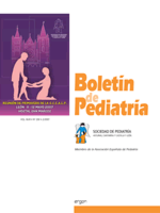Trastorno por déficit de atención con hiperactividad: una actualización
Y. Ramos Vicente , J.C. González Seijo
Bol. Pediatr. 2007; 47 (200): 116 - 124
El trastorno por déficit de atención con hiperactividad es al mismo tiempo el trastorno mental más estudiado en niños y adolescentes y el más controvertido. Este artículo describe la clasificación, epidemiología, manifestaciones clínicas, diagnóstico, etiología, pronóstico y tratamiento del trastorno por déficit de atención con hiperactividad. El objetivo principal del artículo es que pueda ser utilizado como una guía práctica para que los pediatras identifiquen a los niños en situación de riesgo de ser hiperactivos, inatentos o sufrir por su conducta impulsiva. Una vez identificados correctamente, los niños con trastorno por déficit de atención con hiperactividad deben ser tratados. En este sentido, el tratamiento farmacológico ha demostrado claramente su eficacia en el control de los síntomas nucleares del trastorno a corto y medio plazo y en general se considera que la medicación psicoestimulante es segura y bien tolerada en la mayoría de los pacientes. Abstract Attention-deficit/hiperactivity disorder has the distinction of being both the most extensively studied child mental disorder and yet the most controversial. This article describes the classification, epidemiology, clinical description, diagnostic considerations, etiology, prognosis and treatment of attention-deficit/hyperactivity disorder. Therefore the main objective of this article is that it can be used as a practice guide to paediatrician to identify children at risk of being hyperactive, inattentive and suffering for their impulsive conduct. Once correctly identified children with attention-deficit/hyperactivity disorder should be treated. At this point medication treatment is clearly established as effective in terms of suppressing the core symptoms of the disorder in the short and the middle term, and in general it appears that stimulant medication is safe and well tolerated by the majority of patients.
\N
\N
Artículo completo (PDF) (99 kb.)
- Neurología
